| | Snack Food

What are Snacks?
The snack food industry comprises establishments primarily engaged in salting, roasting, drying, cooking or canning nuts; processing grains or seeds into snacks; manufacturing peanut butter; or manufacturing potato chips, corn chips, popped popcorn, hard pretzels, pork rinds and similar snacks.
Snacks are satisfying consumer cravings and the global snack food category has grown at a compound annual growth rate of 10 per cent between 2012 and 2016. In 2016 the snack food industry in Canada was valued at $12.6 Billion.
Consumers primarily define snacks by time of consumption (non-traditional meal hours), and secondarily by item size. Canadians are snacking between meals more often now than in 2016 as they increasingly rely on snacks to get them through their days. According to a recent study. Canadians’ view of snacks is expanding to include beverages as well as a wider variety of foods including healthy food and beverages.
Canadians love their snacks:
- The average Canadian enjoys 12 different types of snacks in a 30-day period.
- Nine in ten Canadians snack multiple times a day on a wide variety of foods that include everything from traditional salty snacks to cookies, crackers, jerky, fruit, nuts and confectionery.
- 55 per cent snack between meals at least twice per day.
- 37 per cent say they typically skip or replace one to two meals per day with snacks.
- 63 per cent somewhat agree that having a snack instead of a meal can be part of a healthy diet.
Snacks now include non-traditional foods once positioned strictly for breakfast, lunch, or dinner meals as illustrated in Figure 1 below.
Figure 1: Top Ranked Non-traditional Foods Consumed as Snacks
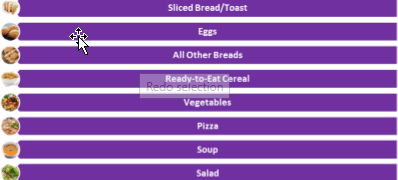
Source: IPSOS
Why Do People Snack?
Time constraints and a desire for convenience result in more than a third of consumers replacing at least one meal per day with snacks. Grab and go snack boxes made daily offer opportunity to meet the demand for convenience.
Mood also plays a pivotal role in snacking as illustrated in Figure 2. In essence, snacking occurs whether people are experiencing positive or negative emotions. Positioning snacks as pick-me-ups and highlighting mood-boosting attributes like antioxidants and vitamin D can help to reach consumers on a deeper level and drive sales.
Figure 2: Influence of Mood on Snacking.

Source: Technomic Canadian Snacking Trend Report
When do Canadians Snack?
Canadians snack throughout the day. However, as depicted in Figure 3, the most popular time for snacking is in the afternoon lead by the 18 – 34 year old age group.
Figure 3: Time of Day Canadians Snack

Source: Technomic Canadian Snack Food Occasion Consumer Trend Report
What do Consumers Snack On?
Consumers snack on a wide variety of items. Only 22 per cent say they typically have the same type of food/beverage each time they snack. As highlighted in Figure 4, beverages are the most preferred snack category followed by baked goods, side items, desserts, appetizers and entrées.
Figure 4: Preferred Snacks by Category
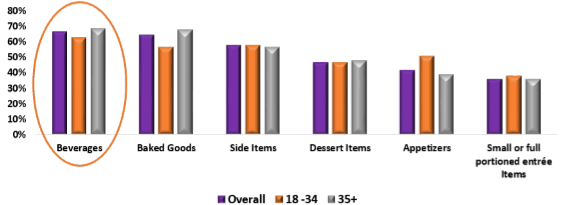
Healthier Snacks
While convenience, availability and taste are still point-of-entry needs for snacking, Canadian consumers are unwilling to sacrifice quality for ease of access. What attributes are consumers seeking in “healthier” snacks:
- High protein
- Energizing
- High fibre
- Stress relieving
- Contains antioxidant
- More fresh, less-processed items
- Higher degree of ingredient transparency and simplicity
- Require their choices to provide premium benefits and meet a higher quality experience.
As depicted in Figure 5, Canadian consumers (32 per cent) say that they are switching to more healthy food and beverages in comparison to 2016.
Figure 5: Shifts Since 2016 – Compared to 2 years ago, I am snacking on…..

Source: Technomic Inc. Canadian Snacking Occasion Consumer Trend Report
Ethnic Snack Food Trends
The popularity of ethnic snacks is relatively low overall, which may be because these options are less widely available than other snacking staples. Snacking is a good way for consumers to experiment with new and ethnic flavours because snacks are less of a cost commitment.
As an example, in the food service sector, adding ethnic appetizers/snacks to menus may help draw in consumers. Integrating unfamiliar ethnic flavors into familiar items like ramen, donair and Caribbean/Jamaican patties can help put consumers at ease. Dish descriptions and photos can help with this as well.
Younger generations tend to be more ethnically diverse and more open to trying new foods. In the food service sector, as noted in Figure 6, among younger consumers, the popularity of ramen is likely due in part to the inexpensive instant packaged version which has become a staple for dorm-dwellers across college campuses. Donairs are also a popular late-night option among this age group.
Figure 6: Ethnic Snacks in the Food Service Sector 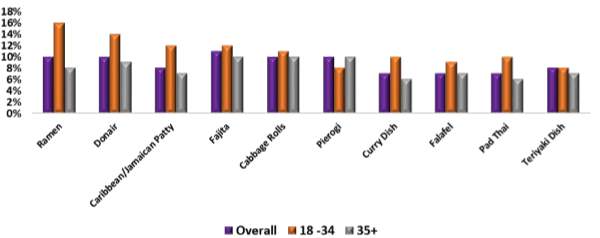
Source: Technomic Canadian Snack Food Occasion Consumer Trend Report
Trends:
While overall snack consumption is rising, there are some particular snacking trends that are experiencing growth such as:
Functional snacks
- Nutritional, functional and filling items positioned as ideal snacks
- Smoothies, juices and other novelties aimed at energizing and hydrating consumers while also staving off hunger
- Increasingly beverages feature superfoods that have been gaining popularity in salads, wraps and other foods
Next-level fries
- Seasoned or “loaded” fries positioned as craveable sides, starters or snacks
- Herbs, cheeses, proteins and sauces adding flavour to an already-popular snack
- MenuMonitor shows a 44 per cent increase in the number of Top 200 chains offering seasoned/herb fries as a side since 2015
- New varieties tend to be distinct from popular poutine by using different, often lighter, ingredients
Amped up veggie snacks
- Cauliflower, Brussels sprouts, artichokes and other trendy vegetables
- Bold sauces, global ingredients often featured to amp up the appeal of veggies
- Vegetables taking the place of proteins in traditional applications, such as Buffalo cauliflowe
International Market Opportunities
As illustrated in Figure 7, global snack food sales are significant. A rare global growth story, snacks are satisfying consumer cravings around the world—in fact, the snacking business grew by US$3.4 billion globally in 2017 with Europe in the lead, followed by Asia-Pacific.
Figure 7: Snack Food Sales Soar Around the World

Source: Nielsen Retail Measurement Services Moving Annual Total Q2 2017
As highlighted in Figure 8, many emerging markets rise to the top of those with an increased appetite for snacks. Seeing sales growth in non-essential categories, like snacks, is a good indicator that consumers in these countries are ready and able to spend beyond the bare necessities, marking an incredible opportunity for snack food companies in these markets.
Figure 8: Where Snacks are Surging

Source: Nielsen Retail Measurement Services
Note: Top measured markets for snacking categories by value contribution
To effectively target snacking demand, consider the following emerging need states (planned indulgence, mindful choice, mood-lifting health, personal health) as key opportunity areas:
Table 1: Key Opportunity Areas
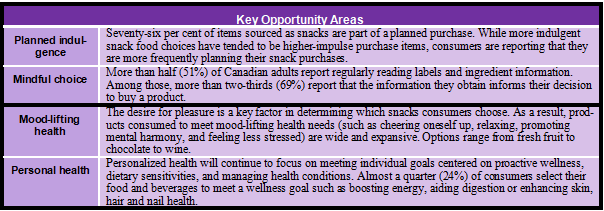
Source: Canadian Grocer
Impact of Age on Snack Food Consumption:
Each generation views snacking differently as illustrated in Table 2. Knowledge of generational preferences can assist in successfully targeting market opportunities in the snack food arena.
Table 2: Generational Preferences for Snack Food
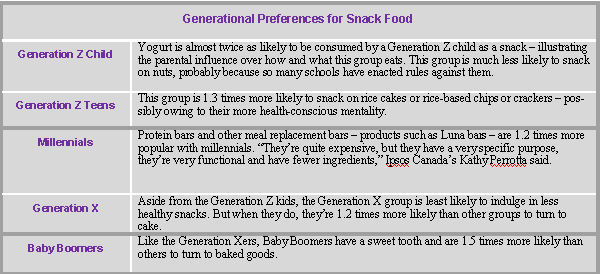
Source: Ipsos FIVE
What does this All Mean?
- There are opportunities for Alberta producers and processors to capitalize on the growing snack food market both domestically and internationally in established as well as emerging markets.
- Because beverages are the most commonly consumed snack items, there are market opportunities for agri-food producers and processors in the beverage snack market. Specifically fruit and vegetable smoothies and juices continue to offer opportunity. Health-halo attributes (e.g., all-natural, GMO-free, additive-free, etc.) in combination with high-protein claims and functional claims such as “energizing,” can help position these beverages as smart meal replacement choices.
- In addition to traditional snacks, consumers are demanding snack foods that are healthier, provide ethnic flavours, and can function as meal replacements.
- Alberta potato growers have an increased market opportunity with the rising consumption of various types of flavoured French fries.
- Target marketing is essential in capitalizing on snack food demand. There are generational shifts in snack food preferences. Although there are many variances among these groups, typically, Baby Boomers prefer snack items such as baked goods while Millennials prefer protein bars, Generation Z children prefer yogurt, Generation Z teens prefer rice cakes or chips and crackers, while Generation X prefer healthy snacks.
- Since 50 per cent of consumers snack 2-3 times per day between meals, these occasions often serve as a pick-me-up. Snacks sold in packaging containing separate compartments with a different type of snack in each could help provide portion control and variety for each separate snacking occasion throughout the day. Marketing could position these snacks as “survival packs” that help consumers get through their days without feeling like they binged on snacks or overate.
|
|